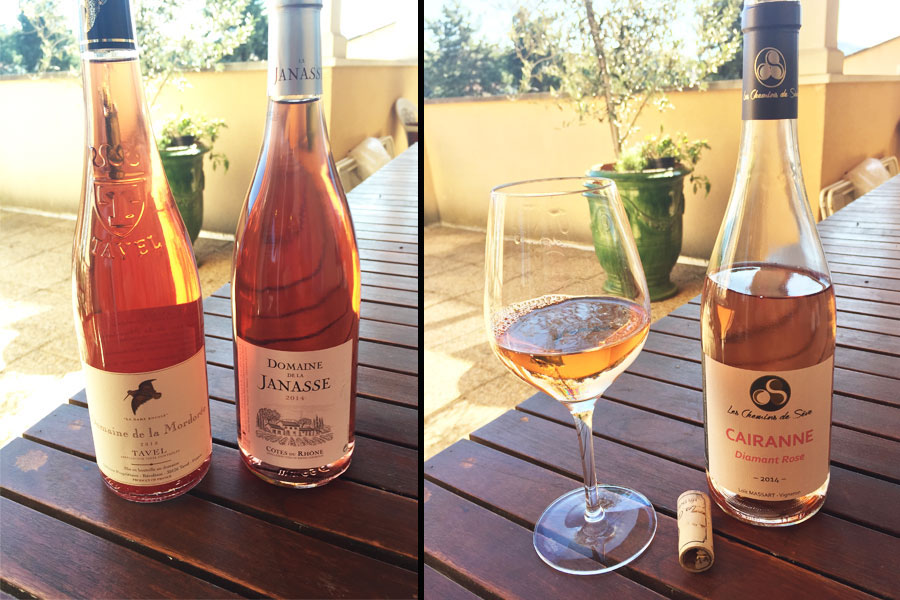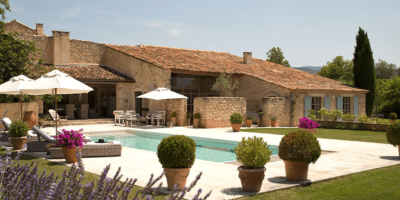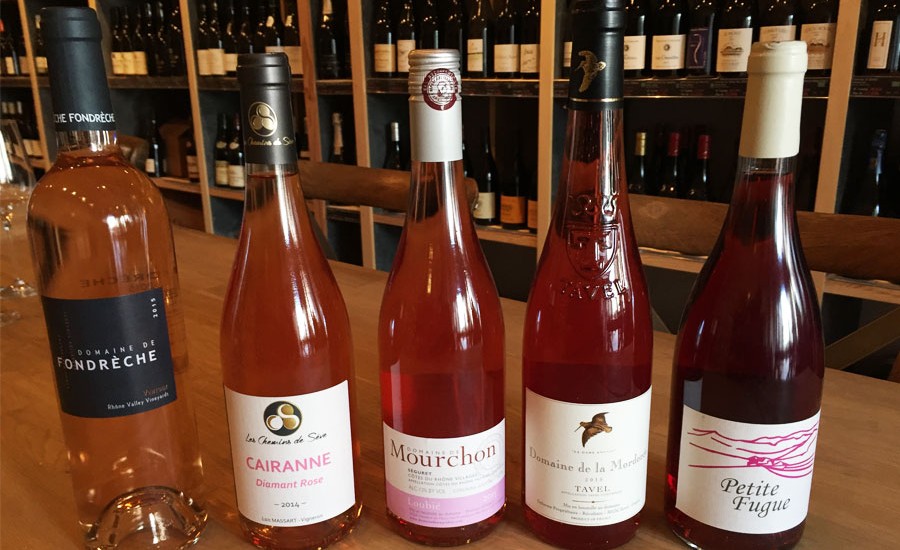The recent warm, sunny spring days have sent me off to my local wine shop/tasting bar, l’Arbre à Vins in Vaison-la-Romaine to find some delicious rosés to drink this spring and summer.
As usual, Mathieu Schillinger, the owner, was happy to give me tastes of the 3 rosés he has open for tasting. I tried the Domaine du Mourchon, the Domaine de la Janasse, and the Domaine de la Mordorée, all of which I loved, and subsequently purchased.
The popularity of rosé is exploding, in France and elsewhere. Rosé is the only French wine whose sales are increasing in the US, up to 40% growth per year. Rosé is produced in many countries and in many regions of France but rosé from the Provence region is usually considered the best and most consistent. It is becoming more and more sophisticated to drink rosé, the quality is improving, there are more and more luxury rosés, and even though the price is going up, these are the most value driven wines in France.
The colors range from very pale, to shell pink, to onion skin, to pale orange, to darker pinks, to a very deep near-purple. There is a nuancier (color chart) to show the many different shades of Provencal rosé; there are 139 shades! But the “Rosé Research Center” experts have grouped these colors into 9 main ones. Sommeliers often use strawberry, light cherry, mango, melon, salmon, ruby pink, peach, pink grapefruit, or wood to describe the colors.
The very pale rosé is trendy in France. Many young women think that the lighter color indicates less alcohol, but this is not the case. Others think that “pale” is sophisticated. The lighter color is due to the style of winemaking, and although it is counterintuitive, the lighter color doesn’t mean less flavor either. Most often, but not always, the very pale rosés come from Provence, the region around the Mediterranean. The big exception is Bandol, whose mourvèdre based rosés are both longer-lasting and intensely flavored. As we move north into the Rhône Valley, Côtes du Rhône rosés become fuller bodied and darker in color. The appellation of Tavel makes only rosé wines, usually full-bodied and flavorful and considered the “best” by many connaisseurs.

Provençal rosés are made in two main ways. In the saignée (bleeding off) method a winemaker wants to concentrate her red wine, so after a short fermentation, some of the juice is “bled” off from the tank, giving a rosé, while the red wine remaining in the tank is more concentrated. In the “direct pressure” method, red wine grapes are harvested early, and fermented. Skins are only allowed a short time in contact with the juice and are removed when the juice is the desired color.
A good rosé is dry, juicy, bright and refreshing to the palate; it has some nice acidity and good flavors of summer fruits and flowers. The best rosés will have some minerality and you might find some herbal flavors as well.
The grapes most often used in Provence for rosés are Cinsault, which gives the strawberry aroma; Grenache gives light cherry and other red fruit flavors and structure to the wine; Syrah for deep color, tannin and spicy dark red fruits; mourvèdre gives structure and body with flavors of dark fruits, herbs and minerals. Some rosés have a taste of bubble gum, which is not appreciated by many French although foreigners seem to like it, according to Mathieu.
Dry rosés come in different styles from a light, lively and fruity style that is best poolside or as an apéritif. “Table rosés” are more full-bodied, may have some oak aging, and are wonderful with food; some can even take the place of a red wine.
There is a third category of rosé in the south of France, which is unfortunately almost unknown outside the region. These are sweet rosés, mainly from the “Cru” rated appellation of Rasteau, but also from Beaumes-de-Venise. Rasteau is better known for is brooding red wines and red VDN (vin doux naturel), but Rasteau produces dry and sweet rosés as well. I recently had a Domaine Combe Julière VDN Rasteau Rosé well paired with a Thai Tom Yam soup. At €11 per bottle, this is a steal. The wine had aromas of crushed strawberries, and other red fruits. In addition to drinking with spicy Asian dishes, the sweet rosé is a wonderful apéritif, a natural with foie gras, and I would love to try it with a strawberry shortcake or raspberry Charlotte.
These rosés are perfect partners to our Provençal cuisine, redolent of garlic, olive oil, and herbs. The lighter rosés are great with marinated red peppers, fresh goat cheese, salads, plates of charcuterie, petite friture (tiny fried smelts); the more full-bodied rosés are preferable with tartare of salmon, grilled sea bass or tuna, stuffed vegetables (“petits farcis”) or a roasted chicken.

On the high end there are some fairly new but exciting rosés. Chêne Bleu from owner Nicole Sierra Rolet is getting a lot of attention for its rosé produced high up in the Ventoux, behind Gigondas, from organic and biodynamic grapes. The wine is perfumed, complex, with a fuller body and wonderful berry nose and good acidity. I buy this one every year! €16.
It should not be surprising that Miraval, the “Brangelina” produced wine from Provence, is quite delicious. Everything the couple does has quality written all over it. They produce this wine in partnership with the well-known Perrin family at Château de Beaucastel. Sacha Lichine –of the famous Bordeaux Lachine family—produces the Château d’Esclans wines Rock Angel and Whispering Angel, which are sometimes considered the “best” rosés, but at a steep price of €15 and €40. Their limited production Garrus goes for about €140. At about €18, the Miraval seems inexpensive. Apparently the Esclans wines are quite popular with yacht owners on the Mediterranean and clubgoers in St Tropez.
Recommended Provençal rosé wines. Best to buy a 2015 vintage. All these wines are exported. Price given is the local price in Provence.
The prestigious Châteauneuf-du-Pape producer Domaine de la Janasse makes an excellent Côtes-du-Rhône rosé for about €6 per bottle.
The “Loubié” rosé, produced by Domaine de Mourchon in Séguret has a big following in the US; early each spring they start shipments to California customers. About €8.5.
Domaine de la Mordorée Tavel, a “Cru” rosé-only appellation producing full bodied rosés. About €14.
Chêne Bleu in the Ventoux region, produces an excellent, complex rosé priced at about 16€ per bottle.
Miraval Rosé, Brad Pitt and Angelina Jolie, with the Perrin Family. About €18 per bottle.
Rasteau Vin Doux Natural Rosé, Ortas, Rasteau. €9 per bottle
L’Arbre à Vins Wine Shop and Tasting Bar, Place Montfort (main square in town) / Trip Advisor
Article and photos: Sharon deRham





